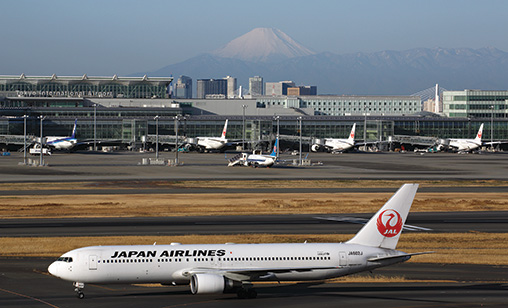News Backgrounder
Yearning for yield
US regulator deliberating allocation of Haneda slots
March 1st 2019
US airlines are vying for a dozen new slots at Tokyo Haneda, whose convenient downtown location sees United command a 12% yield premium over Narita. Read More » But airlines mostly want to move existing Narita flights to Haneda instead of growing the market. They are obfuscating the regulator with its own outdated policy framework.
The larger Asia-North America market is impacted from JV growth, beyond-Tokyo traffic, and how the Delta-Korean Air JV responds.
 |
Japan is expected to divide its 12 US slots evenly between ANA and JAL, which likely will announce routes after US DOT allocation so they can adjust destinations depending on their US partner’s haul.
United tells US DOT that the US-Japan market “is highly competitive and growing”. But expansion is not reflected in slot proposals. Of the 19 proposed flights, only three are confirmed new services from the continental US. It is unlikely all new flight proposals will be awarded slots. Airlines prioritised their requests, usually giving new flights a lower preference. United argues lesser-priorities should not be awarded until every airline has its top priority.
In allocating the 12 slots, there are two Godzillas in the room. First is the role of joint-ventures. DOT is tasked to evaluate the proposals individually without macro considerations. This appears to be in conflict with the goal of maximising public benefits.
Delta argues the US-Japan market will shift to an American-JAL and United-ANA stronghold since ANA and JAL will receive six slots. “Any allocation to ANA is effectively an award to United,” Delta writes. To counter this, Delta requests six slots – half of the US allocation.
DOT previously made decisions independent of JV affiliation, and has rejected calls to treat same-alliance airlines as “single competitive entities”. Yet the JVs are single businesses.
Seeking to reduce anti-competition concerns, United says that on overlapping routes, it and ANA have higher point of sale in their respective home markets: metal-neutral but passenger bias.
United turns allegations into a strength, saying it is explicitly because of the ANA JV that “only United is able to maximize consumer benefits”.
The underlying problem is part of a global discussion how regulators should assess JVs – or even if they can, since DOT approval is indefinite. Adding to the challenge, the most effective solution would probably be reached by regulators working together.
The second problem with assessing routes individually is that the flights often have a majority share of connecting traffic since US airlines tend to structure international flights on hub power and not O&D strength, hence Dallas has three daily flights to Tokyo.
Consumers would benefit from stronger competition in the form of all-new flights and balance between airlines. But this would require broader DOT consideration.
This round of Haneda slots can improve domestic Japan transfers. On United’s only Haneda service, from San Francisco, 20% of passengers make a domestic Japan connection. On its overlapping Narita-San Francisco service, 8% of passengers make a domestic connection.
No airline discusses international connections at Haneda, probably because using Haneda slots for international connections defeats the purpose. But growing Haneda sixth-freedom traffic is inevitable. United has said it now connects in Tokyo more passengers to ANA than it connected to itself when it had a large fifth freedom beyond-Tokyo hub. One-third of United passengers on San Francisco-Narita transfer beyond Japan.
Delta makes its request for four continental US-Haneda slots seem small, but DOT should adjust this high O&D profile to the ANA-United and JAL-American JVs, which may have more Haneda slots but also lower O&D (70-80%) due to higher connections.
One surprise was from American Airlines, proposing the only new city-pair with a Haneda service from Las Vegas.
Hawaiian requested three Haneda-Honolulu slots since Honolulu is the largest US market from Japan, but competitors said this would “balloon” the Haneda-Honolulu market.
Delta’s application has surprising restraint compared to 2013 when then-CEO Richard Anderson held a combative press conference in Japan demanding 25 Haneda slots all for Delta – an unfathomable number, and an event that offended Japan. Delta’s conciliatory approach may reflect the more dignified style of new CEO Ed Bastian.
American’s application makes a poor showing at a time optics are against it, having recently reduced Chicago-Tokyo Narita as well as cancelling some China services. United mentioned American’s previous Tokyo service fumbles and that American serves Japan from only three hubs whereas United serves Japan from all of its hubs. Even though some of American’s hubs have low Tokyo demand, United argues that American should demonstrate Narita success from other hubs before receiving Haneda slots.
In that paradigm, United wants to graduate from Narita primary school to Haneda university while American needs remedial classes and Delta is the schoolyard bully.
DOT needs to find consumer balance between rewarding strength and enabling the weak.